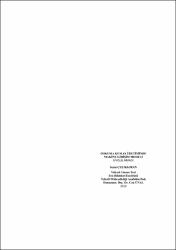| dc.contributor.author | Çelikkıran, Sezin | |
| dc.date.accessioned | 2020-09-15T12:53:57Z | |
| dc.date.available | 2020-09-15T12:53:57Z | |
| dc.date.issued | 2019 | |
| dc.identifier.uri | https://hdl.handle.net/20.500.11776/3688 | |
| dc.description.abstract | Tam entegre çalışan bir tekstil fabrikasında kumaş üretimi iplik hazırlama, iplik üretimi, dokuma hazırlık, dokuma, terbiye ve kalite kontrol proseslerinden oluşur. Dokuma işlemi, tekstilde ipliğin yüzey haline geldiği bir faz değiştirme aşamasıdır ve çalışan yoğunluğu, makine yoğunluğu ve enerji sarfiyat sebebi ile en önemli maliyet işlemlerinden birisidir. Bu çalışmada yünlü kumaş üreten entegre bir tekstil fabrikasının dokuma işletmesinde gerçekleşen makine duruşları ve bu duruşları gidermek amacıyla tahsis edilen çalışan sayısının optimum şartları nasıl sağlayacağı ile ilgili bir uygulama yapılmıştır. Çalışma için işletmede en çok üretilen ürünlerden üçü üzerinde durulmuş ve bu ürünlerin çalıştığı tezgâh grubu ile ilgili veriler toplanmıştır. Toplanan veriler incelenerek kuyruk teoremi yaklaşımına göre çalışan kişinin bakması gereken optimum makine sayısı, maliyetler de göz önünde bulundurularak belirlenmiştir. | en_US |
| dc.description.abstract | In a fully integrated textile factory, fabric production consists of yarn preparation, yarn production, weaving preparation, weaving, finishing and quality control processes. The weaving process is a phase in which the yarn becomes the surface of the textile and is one of the most important cost processes due to the worker intensity, machine intensity and energy consumption. In this study, the machine breakdowns at the weaving mill in an integrated textile factory producing woolen fabrics and the number of employees assigned to eliminate these downtimes have been applied in order to provide optimum conditions. For this study, three of the most produced products in the plant were emphasized and data related to the loom group, where these products were produced, were collected. The collected data were examined and the number of optimum machines to be looked at in accordance with the queueing theorem approach was determined by considering the costs. | en_US |
| dc.language.iso | tur | en_US |
| dc.publisher | Namık Kemal Üniversitesi | en_US |
| dc.rights | info:eu-repo/semantics/openAccess | en_US |
| dc.subject | Dokuma | en_US |
| dc.subject | Optimizasyon | en_US |
| dc.subject | Makine girişim | en_US |
| dc.subject | Kuyruk teoremi | en_US |
| dc.subject | Weaving | en_US |
| dc.subject | Optimization | en_US |
| dc.subject | Machine interference | en_US |
| dc.subject | Queueing theorem | en_US |
| dc.title | Dokuma kumaş üretiminde makine girişim modeli uygulaması | en_US |
| dc.title.alternative | MACHINE INTERFERENCE MODEL APPLICATION IN WOVEN FABRIC PRODUCTION | en_US |
| dc.type | masterThesis | en_US |
| dc.department | Enstitüler, Fen Bilimleri Enstitüsü, Tekstil Mühendisliği Ana Bilim Dalı | en_US |
| dc.relation.publicationcategory | Tez | en_US |



















